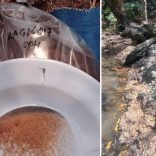Two killed in jihadist attack in northern Mozambique - AFP
Mozambique: The concrete pavement on Avenida Nações Unidas is being destroyed three years later – O País

File photo: O País
The 900 metres of concrete pavement [road] on Avenida das Nações Unidas, which provides access to downtown Maputo city, is being dismantled. The infrastructure, which cost the Municipal Mobility and Parking Company (EMME) more than 21 million meticais, was inaugurated in September 2022 and was supposed to last at least 20 years, but less than three years have passed.
In March 2022, the municipality of Maputo, through the Municipal Mobility and Parking Company, rehabilitated 900 meters of one of the lanes of Avenida das Nações Unidas, in Maputo City, due to the high level of degradation of the road.
This is the roadway that provides access to the city centre, which cost around 21 million meticais to renovate and, four months later in September 2022, was handed over to the public with a promised useful life of at least 20 years.
On 9 June 2022, EMME CEO João Ruas stated: “We have decided to build a completely new reinforced concrete pavement, and this pavement, in accordance with the technical specifications and construction standards, can last 20 to 25 years without maintenance”.
However, on the ground, the opposite was true. The pavement already had cracks, holes and many areas had already been repaired, contrary to João Ruas’ expectations.
As it turns out, in less than three years, the concrete on the superhighway is being completely removed and, in its place, an asphalt road will be laid.
The Ministry of Transport and Logistics is carrying out this intervention, through the Move Maputo project, which, however, clarifies that this road was not supposed to last even 10 years, because it was temporary.
It is a temporary project that cost the Municipal Mobility and Parking Company 21 million meticais, as engineer Afonso Ronda, responsible for the project, explained.
“The Government of Mozambique had initiated a negotiation process with the World Bank to finance a mobility project for the Maputo metropolitan area,” the engineer explains.
“There were several components within this project, and we have a component that we call Component 3, which is the intervention in municipal infrastructures. In this context, the municipality of Maputo identified some arteries to be intervened, and the rehabilitation of Avenida da ONU was included in this package. However, due to the need to mitigate mobility and access issues to the city, the municipality of Maputo implemented a solution to repair this road, while the project was finalizing the procurement procedures, and implemented this solution with concrete, which is now being intervened.”
But why destroy instead of rehabilitate?
In response, Ronda said: “This intervention was carried out by the municipality of Maputo, I had no involvement in the project, so I cannot comment.”
He could not comment, but he clarified that the concrete road had many problems, and the rainwater drainage system was one of them.
“We have extensive interventions here to do, particularly at the level of the drainage system, which involves excavating areas to install drainage systems. In addition, we also noticed that the implemented solution was already beginning to show some defects, which, if we were to put any kind of wear layer on top, would then reflect some of the pathologies that the concrete structure was already showing. To ensure a sustainable solution that minimizes maintenance costs for this infrastructure, we chose to reinforce the structure with a flexible pavement solution,” Afonso Ronda said, especially since there is evidence that, in this case, asphalt is better than concrete.
“Our intervention, which was carried out on the exit lane, was carried out recently, but it is clear that the other lane did not have the same problems as this entry lane, since they are located in the same area, operate under the same conditions and are a flexible structure.
We are confident that this solution with a flexible structure will work, yes, because there is evidence of it on a lane that is right next door, less than 10 meters away.”
With the road completed, Ronda guarantees that the infrastructure will have a useful life of
at least 20 years.
“The intervention that is being carried out, as I said, is being carried out in a robust manner at the level of the drainage system, to guarantee an adequate supply of water, both surface and underground, to minimize the influence of water on the performance of the pavement. We are reinforcing the pavement, as can be seen in the works carried out on the city’s exit lane, using a solution based on a base treated with bitumen. So, these aggregates with some volume of bitumen there, is a hot product prepared in a plant, which will also be a similar
treatment for this entrance strip to the city. With this, we will not only ensure that we have a new wear layer, but, above all, we can ensure that there will be, for at least 15 to 20 years, structural durability of this pavement structure that we are now going to build.”
‘O País’ contacted the president of the Board of Directors of EMME, owner of the work. João Ruas was amazed by the interventions underway, in an infrastructure that, in his view, was of quality.
“I was also surprised when I saw UN Avenue being destroyed. In fact, that same morning, I spoke to the mayor of the city and explained that this was happening and that he didn’t understand what was happening. I don’t know exactly what happened, because the Ministry of Transport is doing the work, through the MOVE project [Maputo]. They are the ones who are doing the work, it is not the municipality of Maputo nor is it EMME, and we do not actually know what the technical or financial reasons are that led to this decision. In fact,
the work that had been done with the reinforced concrete slab, on top of the base that already existed previously, had been a solution that could take, yes, as I said, 20 years. Any engineer can prove this,” Ruas explained, adding that the solution should never have been the destruction of the road.
“I am a civil engineer and have worked in road construction and airport construction. Any concrete pavement has greater expansion coefficients than asphalt. Some cracks appear, and it is natural for them to happen, so it is a matter of maintenance. Now, the solution to avoid cracks was, exactly, to put an asphalt mat on top, not to demolish everything and do it all over again. The solution, as it is being recommended, I believe that there will be weaknesses in the foundation box, in the sub-base and in the base. There will be deformations in the pavement, and I believe that, in a short time, there will be cracks and, consequently, holes. So I think technically the solution is wrong.”
Remember, dear reader, that Engineer Ronda would have said that the concrete infrastructure was a temporary solution. Streets deny this.
“This is absolutely false, because the solution is not actually temporary. When placing a reinforced concrete mat along a road, this solution is not a temporary solution. A temporary solution would be to fill holes and do patching work, etc., etc., which was not the case. We made a carpet 14 centimetres thick, 10 meters wide and 1200 meters long. This can’t be a temporary work, right? Technically, this justification is not correct, because it is not true.”
Contradictions aside, the fact is that, whenever it rained, part of the avenue would be flooded, and this may have been one of the failures, according to Bento Machaila, president of the Federation of Contractors.
“I don’t think it’s in the quality, nor do I think it’s in the lack of engineering. There was probably some omission of work that could have been done. As I said, the drainage system proved to be inefficient. The work was done on the track and they forgot to put in a drainage system that could drain the water much more efficiently.”
For the President of the Federation of Contractors, the lack of funds may be the reason for the lack of a drainage system in the infrastructure. “Often, it happens that the State or the entities that hire have a certain amount to invest in infrastructure and, when it is realized that it is not enough to do all the necessary work, they end up leaving aside some work, like the one I was referring to. Probably, not much was invested in the drainage system because it was thought that it could be done at another time, but nature has shown that, when it rains, the drainage system cannot, under any circumstances, be forgotten for such engineering,” explained Machaila, passing on a message to the government.
“This sends the message that the state or the contracting entities, whenever they have carried out a project, can never leave aside the necessary investments for the drainage system, because they end up destroying all that infrastructure that a lot of money was spent on implementing.”
The deadline for delivery of the rehabilitation works on Avenida das Nações Unidas, budgeted at more than 420 million meticais, is set for April 3. Meanwhile, traffic will continue to be affected, at least during peak hours, on













Leave a Reply
Be the First to Comment!
You must be logged in to post a comment.
You must be logged in to post a comment.